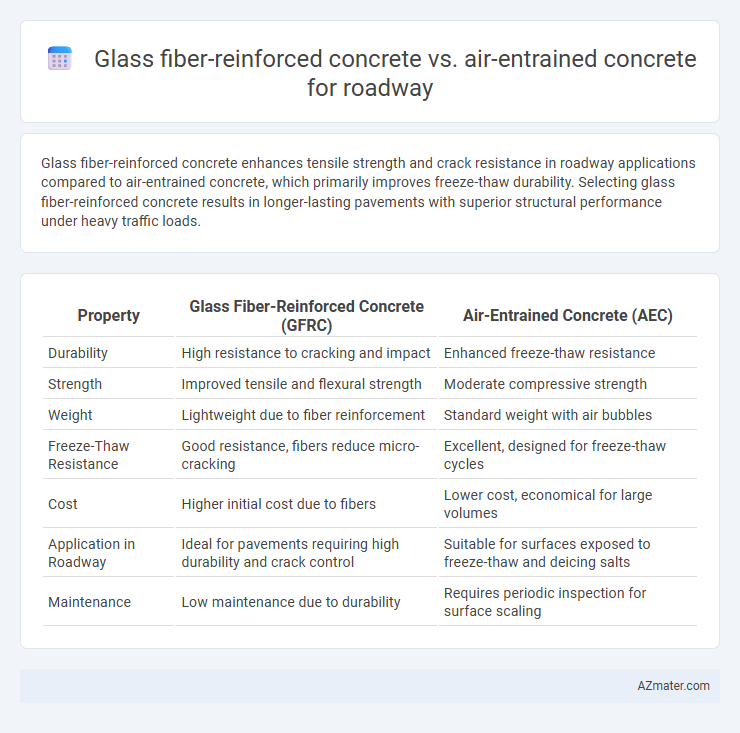Glass fiber-reinforced concrete enhances tensile strength and crack resistance in roadway applications compared to air-entrained concrete, which primarily improves freeze-thaw durability. Selecting glass fiber-reinforced concrete results in longer-lasting pavements with superior structural performance under heavy traffic loads.
Table of Comparison
| Property | Glass Fiber-Reinforced Concrete (GFRC) | Air-Entrained Concrete (AEC) |
|---|---|---|
| Durability | High resistance to cracking and impact | Enhanced freeze-thaw resistance |
| Strength | Improved tensile and flexural strength | Moderate compressive strength |
| Weight | Lightweight due to fiber reinforcement | Standard weight with air bubbles |
| Freeze-Thaw Resistance | Good resistance, fibers reduce micro-cracking | Excellent, designed for freeze-thaw cycles |
| Cost | Higher initial cost due to fibers | Lower cost, economical for large volumes |
| Application in Roadway | Ideal for pavements requiring high durability and crack control | Suitable for surfaces exposed to freeze-thaw and deicing salts |
| Maintenance | Low maintenance due to durability | Requires periodic inspection for surface scaling |
Introduction to Roadway Concrete Technologies
Glass fiber-reinforced concrete (GFRC) enhances roadway durability through improved tensile strength and crack resistance, making it ideal for high-traffic areas prone to stress and environmental wear. Air-entrained concrete incorporates microscopic air bubbles to increase freeze-thaw resistance and reduce scaling, crucial for roadways exposed to harsh climates and frequent temperature fluctuations. Both technologies optimize longevity and performance, with GFRC prioritizing structural resilience and air-entrained concrete focusing on durability against environmental damage.
Understanding Glass Fiber-Reinforced Concrete
Glass fiber-reinforced concrete (GFRC) enhances roadway durability through the integration of alkali-resistant glass fibers that improve tensile strength and crack resistance compared to traditional concrete. Unlike air-entrained concrete, which relies on microscopic air bubbles to increase freeze-thaw durability, GFRC provides superior flexural performance and impact resistance, making it ideal for high-stress roadway applications. The fiber reinforcement in GFRC reduces shrinkage, minimizes surface wear, and extends pavement lifespan in environments subjected to heavy traffic and environmental stressors.
Key Features of Air-Entrained Concrete
Air-entrained concrete incorporates microscopic air bubbles that enhance freeze-thaw durability and reduce scaling caused by deicing chemicals, making it ideal for roadway applications in cold climates. This key feature improves resistance to cracking and prolongs pavement lifespan by maintaining structural integrity under cyclic freezing conditions. Compared to glass fiber-reinforced concrete, air-entrained concrete offers superior freeze-thaw performance but lower tensile strength and impact resistance.
Strength and Durability Comparison
Glass fiber-reinforced concrete (GFRC) exhibits superior tensile strength and crack resistance compared to air-entrained concrete, making it more effective in handling dynamic roadway loads. GFRC's enhanced durability is attributed to its resistance to freeze-thaw cycles and chemical degradation, outperforming air-entrained concrete which primarily relies on air voids to improve freeze-thaw tolerance. In terms of strength retention and longevity under heavy traffic and environmental stresses, GFRC offers a more robust solution for long-term roadway performance.
Performance in Freeze-Thaw Cycles
Glass fiber-reinforced concrete (GFRC) demonstrates superior resistance to freeze-thaw cycles due to its enhanced tensile strength and reduced micro-cracking, improving durability in harsh winter conditions. Air-entrained concrete incorporates microscopic air bubbles that provide space for ice expansion, effectively minimizing internal stress and preventing surface scaling during freeze-thaw cycles. While GFRC offers improved flexural performance and crack control, air-entrained concrete remains the standard for freeze-thaw durability on roadways because of its proven ability to maintain structural integrity and surface quality over time.
Resistance to Cracking and Shrinkage
Glass fiber-reinforced concrete (GFRC) significantly enhances resistance to cracking due to the tensile strength and distribution of glass fibers, which effectively control shrinkage-induced stresses in roadway applications. Air-entrained concrete improves freeze-thaw durability by incorporating microscopic air bubbles but does not provide the same level of reinforcement against cracking and shrinkage as GFRC. For roadways subjected to heavy traffic and temperature fluctuations, GFRC offers superior performance in minimizing shrinkage cracks and extending pavement lifespan.
Workability and Construction Considerations
Glass fiber-reinforced concrete (GFRC) offers enhanced tensile strength and crack resistance but requires careful mixing to ensure even fiber dispersion, affecting workability and necessitating specialized handling equipment during roadway construction. Air-entrained concrete improves freeze-thaw durability through microscopic air bubbles, enhancing workability by increasing plasticity and reducing water content; however, it demands precise air content control to maintain performance. Both materials influence curing times and surface finish quality, with GFRC needing tailored vibration techniques and air-entrained concrete benefiting from standard practices adapted to maintain air void systems.
Cost Analysis: Glass Fiber-Reinforced vs Air-Entrained Concrete
Glass fiber-reinforced concrete (GFRC) typically incurs higher initial material costs compared to air-entrained concrete due to the price of glass fibers and specialized mixing requirements. However, GFRC offers enhanced durability, crack resistance, and reduced maintenance expenses over the lifespan of roadways, potentially offsetting the upfront investment. In contrast, air-entrained concrete provides improved freeze-thaw durability at a lower material cost but may require more frequent repairs and surface treatments, leading to increased long-term expenses.
Environmental Impact and Sustainability
Glass fiber-reinforced concrete (GFRC) significantly reduces environmental impact by enhancing durability and reducing the need for frequent repairs or replacements, lowering overall lifecycle carbon emissions. Its use of recycled glass fibers improves sustainability by repurposing waste materials, contrasting with air-entrained concrete, which primarily enhances freeze-thaw resistance but does not inherently incorporate recycled content. GFRC's longer lifespan and reduced maintenance translate to less resource consumption, making it a more sustainable choice for roadways in environmentally sensitive areas.
Choosing the Best Concrete for Roadway Applications
Glass fiber-reinforced concrete (GFRC) offers superior tensile strength, fracture resistance, and durability compared to air-entrained concrete, making it ideal for roadways subject to heavy traffic and dynamic loads. Air-entrained concrete enhances freeze-thaw durability by incorporating microscopic air bubbles that mitigate internal stress from water expansion but typically has lower tensile strength. For high-traffic or harsh climate roadways, GFRC provides enhanced structural performance and longevity, while air-entrained concrete is better suited for cold environments to prevent surface scaling and cracking.

Infographic: Glass fiber-reinforced concrete vs Air-entrained concrete for Roadway
 azmater.com
azmater.com